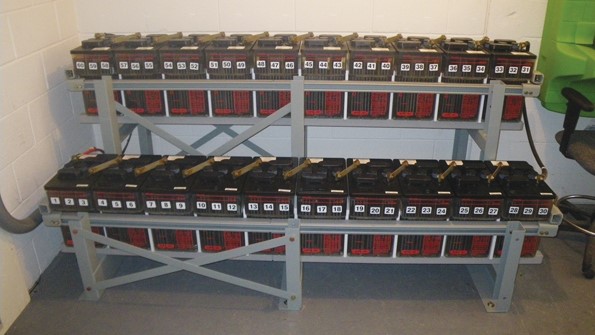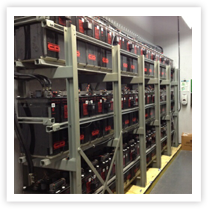Share this
Battery Cabinets vs. Battery Racks
by PowerShield on Aug 27, 2018 2:07:46 PM
This is the seventh in a series of units that will educate you on the part played by a battery in an uninterruptible power supply (UPS) system.
Early on in a UPS design a decision must be made on whether batteries should be installed on racks or in cabinets. Both have pros and cons. The following are typical design considerations.
Battery technology
Vented lead-acid (VLA) (frequently referred to as “flooded” or “wet cell”) batteries, which are sometimes used on very large UPS systems, are ALWAYS rack-mounted.
Valve-regulated lead-acid (VRLA) batteries can be mounted on racks or in cabinets. The remainder of this paper will address considerations for VRLA placement.
Size
Generally speaking, the larger the battery (both physically and ampere-hour rated), the more likely a rack configuration will be considered. There are no hard and fast rules, but typically once a battery unit (single-cell or multi-cell) gets above 100 AH, it favors rack-mount. Below that, cabinet mounting should be considered.
Number
“Number” refers both to the number of cells in a string, and the number of strings. UPS systems frequently operate at high dc voltages (e.g., 250 to 800 Volts). An analysis must be made on whether to have a minimum number of battery strings using physically large units, or to have multiple strings of physically smaller units. Such decision is outside the scope of this paper, but it would include analysis of reliability (e.g., where and how many could the single-point failures be?) and maintainability (e.g., when is a unit too large for a person to handle, thereby requiring special handling equipment?). Every cell-to-cell connection is a potential single point of failure. Redundancy can increase or decrease reliability, depending upon the number of failure points. Anything over about 23 kilograms (50 pounds) is probably too heavy to lift safely. Local and regional workplace safety codes should be consulted for exact threshold.
Location
UPS batteries must be as close as practical to the UPS. They can be located in:
- an electrical equipment room; or
- a battery room; or
- a computer room
Batteries installed on open racks almost always require installation in a battery room. Sometimes they are installed in the same room as the UPS (i.e., electrical equipment room). Local or regional codes may dictate whether batteries are permitted in an electrical room.
Smaller UPS systems (e.g, up to 250 kVA) are commonly installed directly in the computer room along with their respective battery cabinets. The UPS and/or battery cabinets might be configured to look like standard computer equipment racks.
Hazards
There are two primary hazards of concern: electrical and fire.
Open rack batteries expose potentially lethal voltage to any person coming in contact with them. Therefore they must be installed in battery rooms in which room access is restricted to authorized personnel only. Authorized personnel must be trained in battery safety.
Battery cabinets must enclose the batteries behind locked doors accessible only to authorized personnel. As long as the cabinets are kept locked, they can be located in a computer room or other rooms accessible by non-battery technicians.
Because even VRLA batteries can vent hydrogen gas (which is flammable and possibly explosive), ventilation (i.e., air exchanges per hour) must be sufficient to ensure that no pockets of gas can collect at the lower flammability limit (LFL). Local codes will dictate the safety margin, which is usually at least 50% below the LFL. Battery rooms must be equipped with exhaust means, which is usually a fan exhausting air to the outside of the building. Local and regional fire codes will set the requirements.
Because air exchanges in most computer rooms far exceed the ventilation of a normal work environment, placement of battery cabinets in a computer room is rarely a problem.
Electrical considerations
As mentioned earlier, batteries should be as close as possible to the UPS. The reasons are twofold: (1) the longer the cable runs, the greater the voltage drop; and (2) the longer the cable runs, the greater the potential for damage and/or short circuit. Open-rack battery rooms must be adjacent to the UPS room. Battery cabinets must be adjacent to the UPS equipment. Cable lengths from multiple cabinets should be kept as nearly identical as possible to prevent voltage drop variations.
One cabinet should be able to hold at least one complete string of cells. Best practice is that strings should not be split between two cabinets in order to ensure reliability of the entire string.

Figure 1 - Battery cabinet with top terminal cells
A battery disconnect switch should be located as closely as possible to the end of a string. On open battery racks, the disconnect switch can be mounted directly to the rack. On battery cabinets, the disconnect switch should be mounted in the door to allow the battery to be disconnected from the UPS before the door is opened. This best practice is intended to protect a worker from exposure to lethal voltage or arc blast in the event of a fault inside the cabinet.
Convenience
Ease of use is one of the principle selling points for battery cabinets. It is convenient to service the equipment when the UPS and the battery(ies) are right next to each other. Conversely, it is inconvenient to have to go to a separate room when open-rack batteries are installed.
Accessibility
Accessibility must address two potential hazards: electrical and mechanical. The best electrical design will minimize the risk to a worker of accidentally contacting opposite polarity cells with his or her body or with a tool. The best mechanical design will minimize the risk of dropping a unit during installation, maintenance, or removal. It will also minimize the risk of injury due to lifting heavy units above one’s shoulders. Lifting equipment specifically designed for battery installation and removal is recommended. Consult local safety codes for specific restrictions.
From a service perspective, open-rack batteries are usually easier and safer to work on. Racks can be designed with “tiers” (i.e., one row of cells directly above another), or they can be in “steps” (i.e., each row is set back from the row below it so that terminals are accessible with minimum risk of accidentally shorting to the row above.) Tiered racks must allow enough clearance between the top of the cells on one tier and the tier above to allow a technician to safely work on a unit without creating a conductive path between the cell and the rack. Tiered racks can minimize footprint, but they increase floor loading. Stepped racks spread the weight, but take up more space.

Figure 2 - 2-step open rack with top terminal cells
Battery cabinets are frequently criticized for their lack of top clearance. For example, in a cabinet containing multiple strings of low ampere-hour batteries, there might be several shelves, each with one string of cells. The cell units on each shelf might be arranged two, three, or more cells deep. That makes access to the terminals all the way in the back difficult for a technician. Sufficient top clearance for hands and tools becomes critical.
One alternative (usually seen in telecommunication applications, but sometimes seen on UPS), is front-terminal access. Instead of the terminals being on top of the cell units, the terminals face outward. This makes for the easiest access for service, but it requires a cover (usually transparent) or doors to prevent accidental contact with live dc bus. Front terminal systems are usually preconfigured by the battery manufacturer.
Seismic considerations
In areas geographically designated as seismic zones, additional design features will be required. During an earthquake a battery can experience extreme mechanical damage, including:
- inter-cell and inter-tier connectors warping or breaking
- damage to unit containers resulting in electrolyte leakage or spillage
- short circuits resulting in arcing and/or fire
- battery units sliding off their shelves
- racks or cabinets tipping over
Battery racks should have approved seismic ratings form the manufacturer. These typically include heavy-duty frames and rails to prevent batteries from sliding off shelves. The rails add another procedure for installation and removal of battery units (See Figure 3). Because of its length, a battery rack can experience different torques at the same time in different sections of the battery. Good design anticipates these horizontal and vertical torques and provides some flexibility, including flexible inter-cell connectors. Rigidity can result in damage. Racks are typically seismically secured to a concrete floor. Consult local codes for what is acceptable flooring and bracing.

Figure 3 - 3-tier open rack with top terminal cells
An enclosed cabinet reduces the likelihood of batteries sliding off shelves, but the entire cabinet can be prone to movement, especially if it is mounted on a raised floor (which is typical in a data center). Cabinet doors should be locked at all times when the cabinet is not being serviced. Various approaches to securing a battery cabinet include frames or straps under the raised floor. Under-floor frames are subject to the same building code requirements for fastening to the concrete floor as for racks. They actually raise the center of gravity, thereby increasing the possibility of rocking. Strapping must also be seismically secured to the concrete floor, but it has the flexibility to endure some degree of simultaneous vertical and horizontal movement.
Engage a seismic engineer in the design of any battery system in a seismic zone.
Temperature
As mentioned in earlier blogs (see #4 and #5 for failure modes and environment, respectively), temperature must also be considered. Room cooling and ventilation is usually sufficient for rack-mounted batteries. Cabinet design, by contrast, must address the problem of removing heat as well as any off-gassing from the battery. Cabinet-mounted VRLA batteries can be expected to operate in a warmer environment than on a rack, thereby potentially reducing the operational life of the battery. Additional cooling is rarely required for a battery cabinet, but the cabinet must have (1) unobstructed paths within the cabinet for hot air to rise, and (2) adequate openings for hot air and hydrogen gas to escape into the room. The volume of air exchange and the air temperature blown into a properly conditioned computer room usually exceeds the requirements for battery cabinets.
Share this
You May Also Like
These Related Stories

Battery replacement intervals

Speaking the language of batteries

Battery charging regimes
- September 2024 (1)
- December 2021 (2)
- March 2020 (1)
- January 2020 (1)
- December 2019 (1)
- October 2019 (2)
- July 2019 (1)
- May 2019 (2)
- April 2019 (1)
- March 2019 (2)
- January 2019 (1)
- December 2018 (1)
- November 2018 (1)
- August 2018 (3)
- July 2018 (1)
- June 2018 (2)
- May 2018 (2)
- March 2018 (2)
- February 2018 (2)
- January 2018 (1)
- November 2017 (1)
- October 2017 (1)
- August 2017 (3)
- June 2017 (1)
- March 2017 (1)
- November 2016 (1)
- October 2016 (1)
- September 2016 (2)
